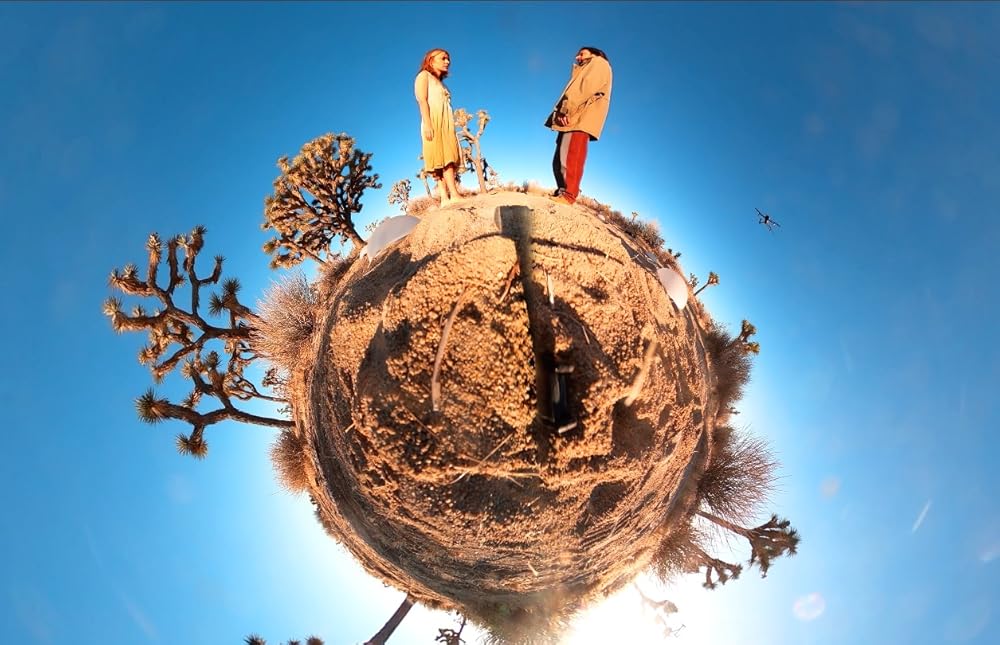Since its 2020 release, I have been talking about and making my friends watch Eugene Kotlyarenko’s Spree. It is the most accurate filmic depiction of the modern Internet (as a cesspool) that I have ever seen. A few weeks ago, I was compelled to the New York premiere of his new movie. The Code takes place in COVID-era Palm Springs and follows a raunchy couple who rents out an Airbnb so that Celine, the girlfriend, can film a documentary of the “unprecedented times” they are living in. Jay, the boyfriend, becomes worried about the around-the-clock, security-style filming that Celine utilizes to make her documentary more realistic. Feeling that Celine is trying to “catch” him, he sets up his own camera system to monitor her. A strange kind of war ensues.
Kotlyarenko’s greatest strength is his resourcefulness. The cast ranges from representatives of New York’s ever-reactionary “Dimes Square” to Casey Frey of Vine virality. With the placement of these landmark Internet figures, fans of Peter Vack and Dasha Nekrasova are bound to flock to this movie and laugh at characters who are as addicted to the Internet as themselves. At the New York premiere of The Code, an overwhelming number of audience members were on their phones right until the start of the movie. During the Q&A, an audience member asked a question about Kotlyarenko’s Instagram live streams during which he would be overseeing the editing of The Code. I logged into Letterboxd after leaving the premiere to find that many audience members had already star-rated the movie and written their glowing reviews. One does not have to fully understand Internet culture to enjoy The Code’s lampoons of the Internet, but the biggest audience laughs came from specific Internet references. The Code is about the Internet, houses Internet stars, and one’s engagement with the films depends on one’s engagement with the Internet.
The audience takes on a kind of double viewership by watching both Kotlyarenko’s movie and the one captured by Jay and Celine’s cameras. The perspective switches between the dozens of cameras constantly, demonstrating the self-imposed security state. Celine and Jay can see each others’ every move without ever actually connecting. They are more entwined with their respective phones, which produces a kind of sad humor that seems to be The Code’s epitome. Suddenly, though, Kotlyarenko yanks the plot in a new direction that spoofs on the flashback reveal structure of films like Knives Out. The third act switch-up seems to be tongue-in-cheek and is tedious to get through. However, the resolution is uniquely beautiful. The last scene of Celine’s documentary combines Kotlyarenko’s previous commentary on Internet surveillance with a biblical spin; Jay becomes Adam and Celine becomes Eve, they are the last two people on the globe created by a 360 degree camera.
The question, then, becomes whether Jay and Celine have cracked the titular “code”. At first, the word refers to the passcodes to Jay and Celine’s phones that they ask each other for at the beginning of their surveillance frenzy. The word is again prevalent when Jay and Celine are at an escape room and work together. For the final code, Celine’s love is at stake. She runs away and Jay will only be able to see her again if he can crack this code. The figurative thread that runs through all of these codes is the issue of undoing their respective Internet addictions. If Jay and Celine can crack the code, they can arrive at a connection unclouded by phones and cameras. Why, then, is Celine still filming them at the climax of the movie? Jay has already solved her elaborate code and they finally come together again. Here, Kotlyarenko shows just how absurdly indelible technology has become. The audience is trapped in the portal of Celine’s cameras and Celine continues to carry out her actions as a performance for her film. Because Celine and Jay know there is an audience, they cannot have an authentic relationship. Kotlyarenko shrouds this desolate idea in the newfound beauty of the film’s only high definition scene. Jay and Celine’s heavenly elopement seems to be the peak of human connection, but their intimacy remains unreal as long as the cameras are on.
– Eamon Costello

